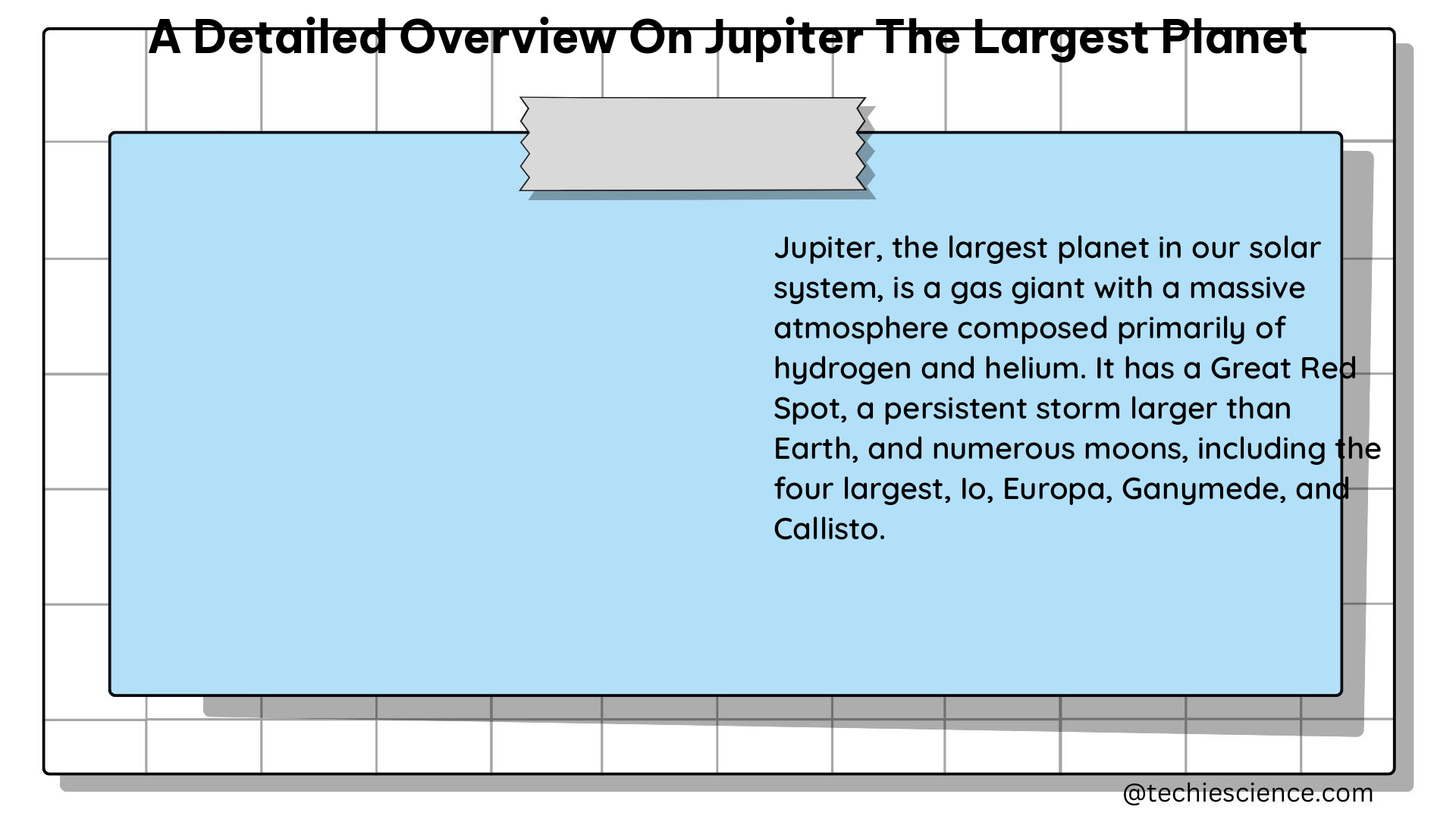Jupiter, the largest planet in our solar system, is a true giant, with a wealth of fascinating characteristics and a rich history of exploration. As the fifth planet from the Sun, Jupiter’s sheer size and complexity have captivated astronomers and scientists for centuries. In this comprehensive blog post, we’ll delve into the intricate details of this colossal world, exploring its physical properties, atmospheric features, magnetic field, and more.
Physical Characteristics
Jupiter’s immense size is truly staggering. With an equatorial diameter of 143,000 km (88,900 miles), it is over 11 times the diameter of Earth. Its mean distance from the Sun is 778,340,821 km (5.2 astronomical units), and its orbit has an eccentricity of 0.048 and an inclination of 1.3° to the ecliptic. The Jovian year, or the planet’s sidereal period of revolution, is 11.86 Earth years, and its visual magnitude at mean opposition is a striking -2.70.
Jupiter’s rapid rotation is another remarkable feature, with a mean synodic period of 398.88 Earth days and a mean orbital velocity of 13.1 km/sec. The planet’s equatorial radius is 71,492 km, while its polar radius is 66,854 km, indicating a significant oblate spheroid shape. Its mass is an astounding 18.98 × 10^26 kg, with a mean density of 1.33 g/cm^3 and a surface gravity of 2,479 cm/sec^2. The planet’s escape velocity is a staggering 60.2 km/sec.
Rotation Periods

Jupiter’s rotation is complex, with three distinct systems:
- System I (±10° from Equator): 9 hr 50 min 30 sec
- System II (Higher Latitudes): 9 hr 55 min 41 sec
- System III (Magnetic Field): 9 hr 55 min 29 sec
This variation in rotation periods is a result of the planet’s dynamic atmospheric conditions and the complex interactions between its layers.
Magnetic Field and Magnetosphere
Jupiter’s magnetic field is incredibly powerful, with a strength of 4.3 gauss at the equator. This immense magnetic field, the largest in the solar system, creates a vast magnetosphere that extends millions of kilometers into space, trapping charged particles and creating a dynamic and complex environment.
Atmosphere
Jupiter’s atmosphere is primarily composed of hydrogen and helium, with the former making up approximately 90% of the composition. The planet’s cloud bands, which are visible from Earth, are created by cold, windy clouds of ammonia and water. One of the most famous features of Jupiter’s atmosphere is the Great Red Spot, a giant storm larger than Earth itself, with a diameter of about 16,350 km (10,159 miles).
Moons and Ring System
Jupiter has an extensive system of moons, with a total of 95 known satellites. The planet also has a main ring and three less-dense ring components, forming a complex and dynamic ring system.
Formation and Structure
Jupiter is believed to have formed from the dust and gases left over from the Sun’s formation, approximately 4.5 billion years ago. The planet’s core is partially dissolved, with no clear separation from the metallic hydrogen around it, leading researchers to describe it as “fuzzy.”
Exploration
Jupiter has been the subject of extensive exploration since the first detailed observations made by Galileo Galilei in 1610. The most recent mission to the planet is NASA’s Juno spacecraft, which has been studying the giant planet from orbit since 2016.
Additional Facts
- Jupiter is the oldest planet in the solar system, having formed from the same dust and gases that gave rise to the Sun.
- The planet has the shortest day in the solar system, with a rotation period of only 10.5 hours.
- Despite its immense size and powerful gravitational field, Jupiter is unlikely to support life as we know it due to its extreme temperatures, pressures, and atmospheric composition.
References
- Britannica. (2024). Jupiter – Gas Giant, Moons, Orbit | Britannica. Retrieved from https://www.britannica.com/place/Jupiter-planet/Basic-astronomical-data
- NASA. (n.d.). Jupiter: Facts – NASA Science. Retrieved from https://science.nasa.gov/jupiter/jupiter-facts/
- NASA. (n.d.). Jupiter – NASA Science. Retrieved from https://science.nasa.gov/jupiter/
- PBS LearningMedia. (2016). Jupiter: The Largest Planet – PBS LearningMedia. Retrieved from https://thinktv.pbslearningmedia.org/resource/npls12.sci.ess.eiu.juplarge/jupiter-the-largest-planet/
- Space.com. (2023). Jupiter: A guide to the largest planet in the solar system – Space.com. Retrieved from https://www.space.com/7-jupiter-largest-planet-solar-system.html

Hi, I am Sanchari Chakraborty. I have done Master’s in Electronics.
I always like to explore new inventions in the field of Electronics.
I am an eager learner, currently invested in the field of Applied Optics and Photonics. I am also an active member of SPIE (International society for optics and photonics) and OSI(Optical Society of India). My articles are aimed at bringing quality science research topics to light in a simple yet informative way. Science has been evolving since time immemorial. So, I try my bit to tap into the evolution and present it to the readers.
Let’s connect through